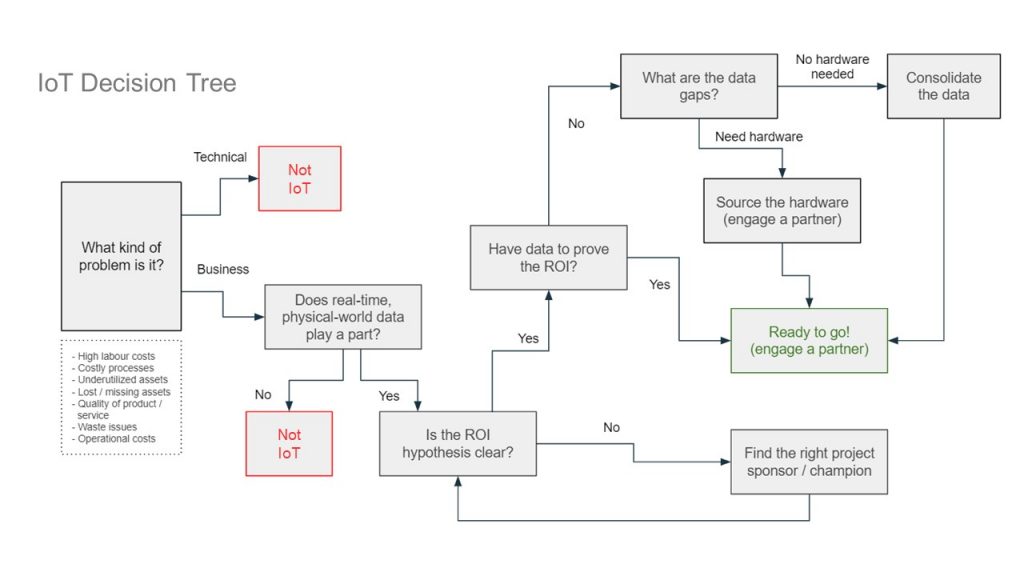Much has already been written about the revolution that AI + IoT is going to catalyse.
The fact that we’re in the midst of the 4th industrial revolution doesn’t mean we’re going to wake up one day and a tsunami will have occurred that’s destroyed many of the industries that we’ve relied upon and made swathes of businesses obsolete or uncompetitive.
The truth is change is a constant, but disruption is rare, and integrated data, AI + IoT technologies are one of those that will drive real, permanent change for lots of industries. However, that doesn’t mean it's the solution to all of your business issues, or even all of your data-related problems. There are two very simple reasons as to why this is the case for IoT:
- IoT, real-time data integration and analysis is complicated (and potentially costly) to implement; and
- Not everything yet has a use case or has been proven to be of business benefit - they're nice-to-haves.
There is absolutely no doubt that integrated data, AI + IoT platforms will transform industries, create new ways of operating, and that done well will provide businesses with a competitive advantage. However, for that to happen, the technology - or more specifically collection of 5 things that make an AI + IoT solution - needs to be able to demonstrate bottom-line benefits to an organisation or they simply won’t be implemented.
How integrated data, AI + IoT platforms will drive change.
The only way to do that is to test the solution in-situ with particular use cases designed to fix a specific problem. Yes, there may well be established use cases and productised solutions that exist within your industry designed to manage a specific function or process, but until you’ve implemented IoT and applied it to a particular problem in your environment, you will never know the true potential for it to impact your specific business.
The reason for this is that every field, production line, building, or retail site is different. It’s used in different ways, by different people, in different places. Your raw ingredients, tools and technologies are different. You run at different speeds, temperatures and times. Your business, sector, and space is unique; and for IoT to make a difference to you, it – or, more specifically, the people implementing it – needs to know that.
It’s also really important to note, too, that data, AI + IoT platforms aren’t likely to take people out of the formula and digitise or automate everything. What it enables you to do is create a method for standardising the way you collect and combine data, analyse it in real-time, and make smarter operational decisions that save you time and money.
The IoT decision tree: what is and isn’t a project
Integrated data, AI + IoT platforms have thousands (if not millions) of different potential applications to your business and sector. It’s likely that, at this stage, only a handful of them are worth worrying about.
To help you determine whether the problem you’re assessing might be an IoT one, you can use Rayven’s IoT decision tree:

Taking this a step further, Rayven believes that integrated data, AI + IoT platform technology makes sense only when:
- You’re collecting data from a sufficient number of sources that can be combined, ETL and analysed to identify areas for improvement (Data Science);
- The platforms that you’re putting in are able to 'learn' from what they’re doing, and can affect change i.e. have machine learning, automation + direct machine control capabilities; and
- When the people that are building the front-end solution that your people will actually use understand you, your sector, and are able to create a solution that meets your precise needs (Industry and Business Knowledge).
To deliver meaningful change to a business, integrated data, AI + IoT platforms need to fit it like a glove. When engineered, your end solution needs to be created for a defined purpose and be comprehensive - the inputs be wholly known and the outputs readily measurable.
To successfully adopt novel technologies like ours, you need to find its true value, closely examine each use case, determine whether integrated data, AI + IoT platforms are the right way of solving them, and start small (whilst thinking big) before proving its efficacy and scaling.
If you need help or would like to explore potential use cases within your business or for you customers, reach out to us today and let's set-up a time to talk - we'd love to help.